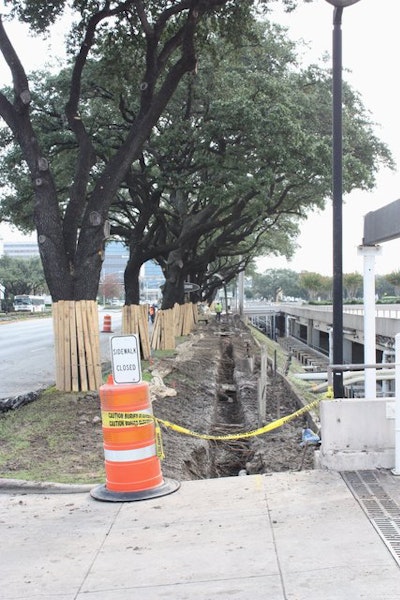
Interested in Trucks?
Get Trucks articles, news and videos right in your inbox! Sign up now.
Trucks + Get AlertsWorking in sales and marketing for the largest fleet of hydroexcavators in Texas, Karl Lassberg doesn’t see conventional excavators as competition. “We’re really working in conjunction with mechanical equipment,” says Lassberg, of T-Rex Services Hydro Excavation and Industrial Vacuum Services.
Founded with one truck in 2001 by former NASCAR driver Bobby Hillin Jr., T-Rex now has a fleet of more than 38 hydroexcavation and vacuum excavation trucks. “At the time, there wasn’t a lot of hydroexcavation going on in the southern Gulf region,” Lassberg says. “He just went out there and hustled, and the popularity of hydroexcavation has grown over the last decade as the awareness of the technology has grown.”
Besides the usual safe exposure of underground utilities, it has also grown more popular for many other uses, especially in confined areas. Lassberg cites a recent job as a good example, a lift station for a restaurant. The excavation was only 4- by 4- by 6-feet but required hand digging because the location was inside a parking garage. “It would have taken several days to dig and carry out 3.6 cubic yards of dirt by hand,” he says. “We ran a remote hose down a stairwell and it took us less than three hours. Our bill was much cheaper than a hand dig.”
He adds that hydroexcavation is also a good alternative to an auger for digging holes. “If you have only a couple of holes to dig with an auger, hydroexcavation can be competitive because the material is sucked straight into the truck and dumped off site,” Lassberg says. “You don’t have to worry about additional equipment to scoop it up and haul it away.”
The advantages are even greater when it comes to utility pole holes, usually 18 inches in diameter and 8-feet deep. Two people with posthole diggers will need about two hours to do a single hole while it’s a 10- or 15-minute job with hydroexcavation.
Lassberg says electro-mechanical work has led to a lot of hydroexcavation work in recent years, such as grounding wire trenches, 6 inches wide and 18 inches deep, that used to be dug by hand. “We can hydroexcavate 300 to 400 feet of that in one day and cover it with a skid-steer instead of putting five guys trying to dig for days at a time.”
One such project was at a lighting conduit project at the Galleria Mall in Houston in September 2010 – 700 feet of trench (2 feet wide and 2 feet deep) underneath a sidewalk bordered by a long line of historic oak trees. “With all those tree roots, you have to dig a little differently and more conscientiously,” Lassberg says. “If you even skin a tree root you can kill the tree, so digging by hand is very tricky business.”
In this case, all the roots crisscrossing through the excavation area made any other sort of excavation impossible. Since tree roots can also be damaged by high-pressure water, the excavators used lower pressure and kept nozzles well way from the roots. The job also had to be done in 48 hours in a high traffic area of the city’s busiest area. T-Rex brought in five trucks. “We started Friday at 9 p.m. and finished 40 percent ahead of schedule,” Lassberg says. “Two years later, the trees are still in great condition.”
Consider the options
Lassberg says there are three main issues to think about when considering hydroexcavation. Is there a source of water on site? Can the spoils be dumped on site? And how close can the truck get to the excavation?
“Most trucks require a water source, whether it’s a fracking tank, water truck, hydrant, or a pond,” he says. “Dumping on site usually makes a job much more productive. Dumping off site means driving to a dump site and back, sometimes there are dumping fees. Access within 15 or 20 feet from the dig site allows for the greatest productivity but we can work 300 to 400 feet away from the truck when necessary.”
When he first got involved in the industry, it seemed people assumed he was in competition with other excavators. “They were a little leery of me,” he adds. “The first thing I tell people is that hydroexcavation is a great tool to have in their arsenal — for the right job.”







